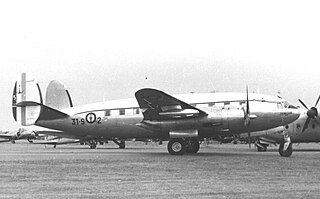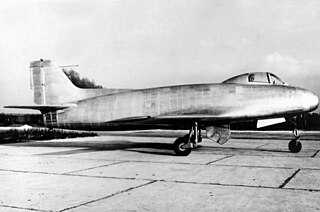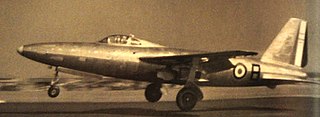Related Research Articles

SNCASO was a French aircraft manufacturer.

The Sud-Ouest Aviation (SNCASO) S.O. 4050 Vautour II was a French jet-powered bomber, interceptor, and attack aircraft developed and manufactured by aircraft company Sud Aviation.

The Rolls-Royce RB.41 Nene is a 1940s British centrifugal compressor turbojet engine. The Nene was a complete redesign, rather than a scaled-up Rolls-Royce Derwent, with a design target of 5,000 lbf (22 kN), making it the most powerful engine of its era. First run in 1944, it was Rolls-Royce's third jet engine to enter production, and first ran less than 6 months from the start of design. It was named after the River Nene in keeping with the company's tradition of naming its jet engines after rivers.

The Armstrong Siddeley Sapphire is a British turbojet engine that was produced by Armstrong Siddeley in the 1950s. It was the ultimate development of work that had started as the Metrovick F.2 in 1940, evolving into an advanced axial flow design with an annular combustion chamber that developed over 11,000 lbf (49 kN). It powered early versions of the Hawker Hunter and Handley Page Victor, and every Gloster Javelin. Production was also started under licence in the United States by Wright Aeronautical as the J65, powering a number of US designs. The Sapphire's primary competitor was the Rolls-Royce Avon.

The Bréguet Br 960 Vultur was a prototype two-seat carrier-based attack and anti-submarine aircraft (ASW) built for the French Navy during the early 1950s. Meeting contradictory endurance and speed requirements, it was designed as a "mixed-power" aircraft with a turboprop engine in the front and a turbojet in the rear. Only two examples were built, but the second aircraft was rebuilt as the prototype of the Bréguet 1050 Alizé ASW aircraft after the Navy dropped the idea of a turboprop attack aircraft in the mid-1950s.

The Klimov VK-1 was the first Soviet jet engine to see significant production. It was developed by Vladimir Yakovlevich Klimov and first produced by the GAZ 116 works. Derived from the Rolls-Royce Nene, the engine was also built under licence in China as the Wopen WP-5.

The Short SA.4 Sperrin was a British jet bomber design of the early 1950s, built by Short Brothers and Harland of Belfast. It first flew in 1951. From the onset, the design had been viewed as a fall-back option in case the more advanced strategic bomber aircraft, then in development to equip the Royal Air Force's nuclear-armed V bomber force, experienced delays; the Sperrin was not put into production because these swept-wing designs, such as the Vickers Valiant, were by then available.

The SNCAC NC 1080 was a French jet-engined interceptor developed in the late 1940s by SNCAC for use aboard aircraft carriers. It was intended to compete for an Aéronavale contract and first flew in 1949. The aircraft used an innovative system of flight control surfaces that proved to be a failure during flight testing and had to be modified before it could fly again. Its development was troubled by other design flaws and the company's merger with SNCAN that same year. Further development was cancelled after a fatal crash destroyed the sole prototype in 1950.

The Gloster E.1/44 was a British single-engined jet fighter design of the Second World War, developed and produced by the British aviation firm Gloster Aircraft Company. It was amongst the first jet-propelled aircraft to be developed and was produced on an experimental basis.

The Sud-Ouest S.O.30 Bretagne was a 1940s French airliner built by Sud-Ouest.

The Arsenal VG 90 was a French carrier-based jet-engined interceptor developed in the late 1940s. It was intended to compete for an Aéronavale contract and first flew in 1949. It set a speed record for a French aircraft the following year, but both of the completed prototypes were destroyed in fatal crashes and the program was cancelled in 1952 before the third prototype was finished. The Aéronavale contract was eventually awarded to a license-built British aircraft. The remains of the last VG 90 were scrapped in 1978.

The Sud-Ouest SO.6000 Triton was an early experimental French jet aircraft. It has the distinction of being the first indigenously-designed jet-powered aircraft to be flown by the nation, having been designed and manufactured during the 1940s by the French aircraft construction consortium SNCASO.

The Tupolev Tu-12 was an experimental Soviet jet-powered medium bomber developed from the successful piston-engined Tupolev Tu-2 bomber after the end of World War II. It was designed as an interim aircraft to familiarize Tupolev and the Soviet Air Forces (VVS) with the issues involved with jet-engined bombers.

The Nord 2200 was a French carrier-based, jet-engined interceptor developed in the late 1940s. It was intended to compete for an Aéronavale contract, but was not selected for production after a 1950 accident badly damaged the sole prototype. It was repaired and resumed flight testing the following year, which including evaluating rocket-assisted take offs. After the aircraft made its last flight in 1954, it was used as a gunnery target. Much of the airframe was recovered in the 1980s, but its current disposition is uncertain.

The SNCASO SO.9000 Trident is a French mixed-power interceptor aircraft built by aircraft manufacturer SNCASO during the 1950s. As part of a wider effort to re-build French military power during the late 1940s and to furnish France with advanced, new domestically produced designs, a request for a supersonic-capable point-defence interceptor aircraft to equip the French Air Force was issued to SNCASO. In response, the firm designed the mixed-propulsion Trident, powered by a single SEPR rocket engine, which was augmented by wingtip-mounted turbojet engines, and the Air Force ordered two prototypes.

The SNCASE Grognard was designed as a single-seat, low-level ground-attack aircraft. Although in development in the 1950s for the French Armée de l'Air, the program was cancelled in favor of the Sud-Ouest Vautour II.

The Tupolev '73',, was a Soviet trijet medium bomber of the late 1940s. It lost out to the Ilyushin Il-28 'Beagle'.

The Sud-Ouest SO.6020 Espadon (Swordfish) was a French post-war prototype interceptor designed and built by SNCASO during the late 1940s. The French Air Force judged the design a failure despite some records being set and cancelled plans to put it into service in 1951. Only four aircraft were built and they were later modified to serve as testbeds for the mixed rocket and turbojet-powered SNCASO SO.9000 Trident program. Only one badly damaged aircraft survives.

The SNCAC NC.1070 was a piston engined attack and torpedo bomber designed and built in France shortly after World War II. The second prototype, the NC1071, was the first French multi-jet turbine powered aircraft.
The SNCAC NC.271 was a French experimental aircraft built by SNCAC in the late 1940s, as a 1:2.5 scale model of the proposed SNCAC NC.270 jet bomber, featuring swept-back wings, using SNCASE SE-161 Languedoc N0.31 F-BCUT as a launch platform.
References
Citations
- 1 2 3 4 5 6 7 8 Gunston and Gilchrist 1993, p. 69.
- ↑ "IAF Aircraft Inventory: Sud-Ouest S.O. 4050 Vautour." Jewish Virtual Library, Retrieved: 16 September 2017.
- 1 2 Caygill 2006, [ page needed ].
- 1 2 3 4 5 Gunston and Gilchrist 1993, p. 68.
- ↑ Griehl, Manfred; Dressel, Joachim (1998). Heinkel He 177 - 277 - 274. Shrewsbury, UK: Airlife Publishing. pp. 208–209. ISBN 1-85310-364-0.
- 1 2 3 4 5 Air International January 1986, p. 46.
- ↑ "Le Sud-Ouest SO-4000: I. Origine". Le Sit des Projets et Prototypes d'Avions, 14 May 2003. Retrieved 15 May 2011.(in French)
- ↑ "Le Sud-Ouest SO-4000: V. Essai et abandon du SO-4000". Le Sit des Projets et Prototypes d'Avions, 14 May 2003. Retrieved 15 May 2011.(in French)
- 1 2 3 Gunston and Gilchrist 1993, pp. 68-69.
- ↑ Flight 12 May 1949, p. 552.
- ↑ "Le Sud-Ouest SO-4000: II. Le NC-270 & le SO-4000". Le Sit des Projets et Prototypes d'Avions. 14 May 2003. Retrieved 15 May 2011.(in French)
Bibliography
- "An Abortive Bomber". Air International , January 1986, Vol 30 No 1. Bromley, UK: Fine Scroll. p. 46. ISSN 0306-5634.
- Buttler, Tony. X-Planes of Europe II: Military Prototype Aircraft from the Golden Age 1946–1974. Manchester, UK: Hikoki Publications, 2015. ISBN 978-1-90210-948-0
- Caygill, Peter. Sound Barrier: The Rocky Road to MACH 1.0+. Pen and Sword, 2006. ISBN 1-47381-843-5
- Cuny, Jean (1989). Les avions de combat français, 2: Chasse lourde, bombardement, assaut, exploration[French Combat Aircraft 2: Heavy Fighters, Bombers, Attack, Reconnaissance]. Docavia (in French). Vol. 30. Ed. Larivière. OCLC 36836833.
- Gaillard, Pierre & Marchand, Alain (December 1981). "Le S.O. 4000 (4)" [The S.O. 4000 Part 4]. Le Fana de l'Aviation (in French) (145): 8–13. ISSN 0757-4169.
Guignard, Jacques (December 1981). "L'avion d'un seul vol" [The Plane of a Single Flight]. Le Fana de l'Aviation (in French) (145): 9. ISSN 0757-4169.
- Gunston, Bill and Peter Gilchrist. Jet Bombers: From the Messerschmitt Me 262 to the Stealth B-2. Osprey, 1993. ISBN 1-85532-258-7